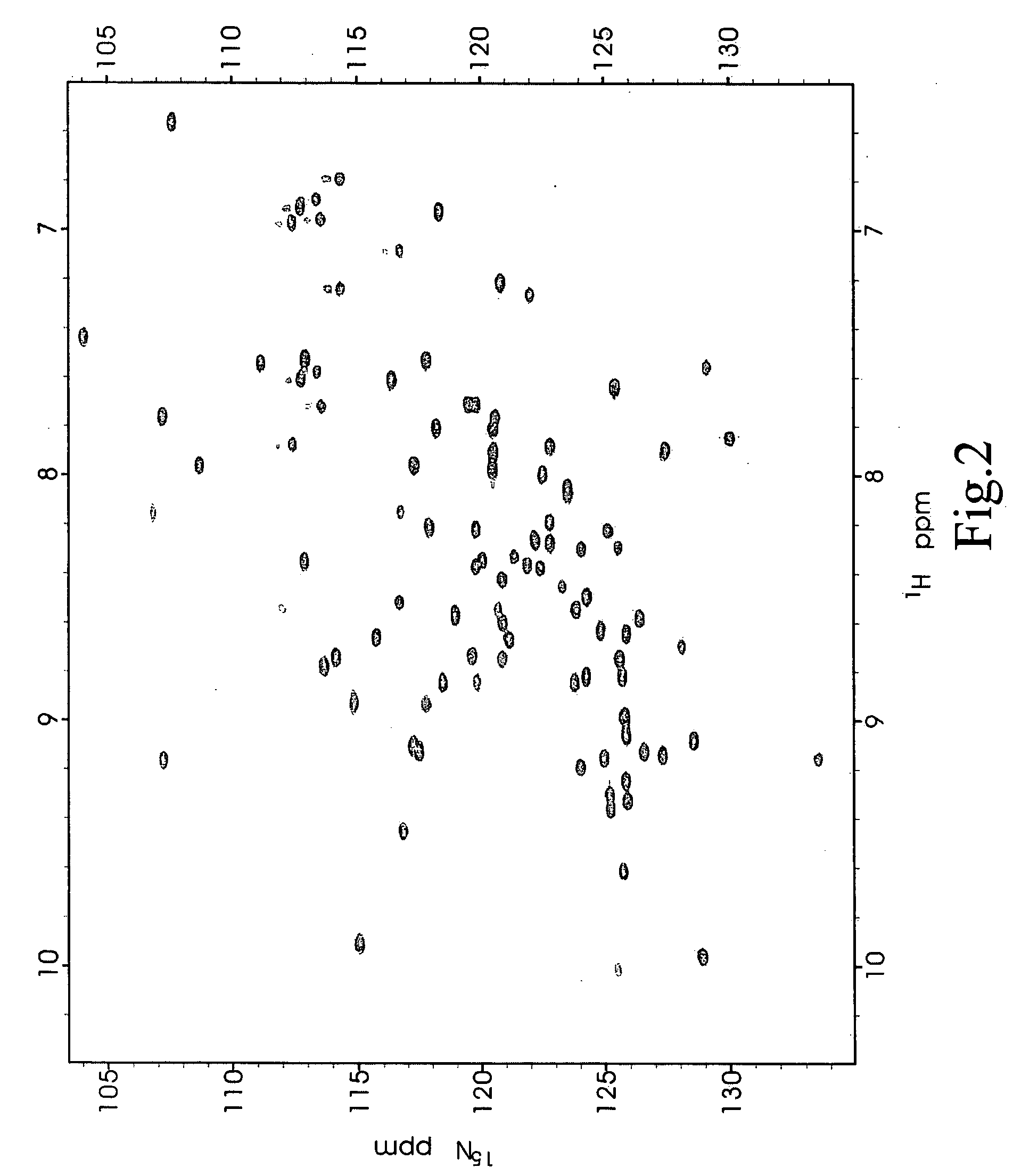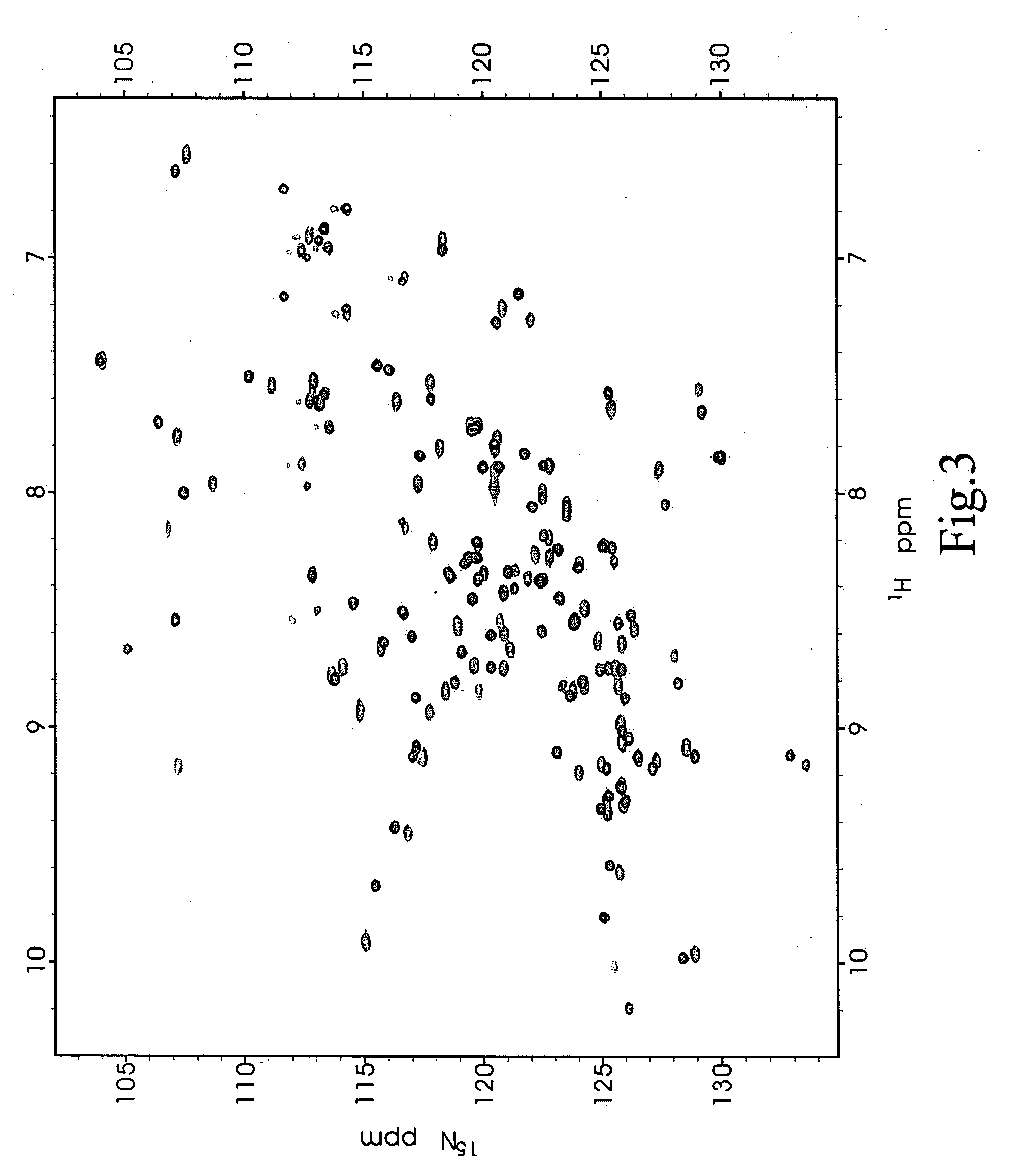Drug screening method for the treatment of brain damage
a brain damage and drug screening technology, applied in the direction of biochemistry apparatus and processes, instruments, material analysis, etc., can solve the problems of neuronal damage, difficult to prevent stroke-induced neuronal damage by direct inhibition of nmda receptors, and difficult to prevent stroke-induced neuronal damage. direct inhibition of nnos can solve the problem of neuronal damage prevention, and achieve the effect of reducing damag
- Summary
- Abstract
- Description
- Claims
- Application Information
AI Technical Summary
Benefits of technology
Problems solved by technology
Method used
Image
Examples
example 2
NMR Analysis of Free PDZ2 Protein
[0034] In this specific non-limiting example, the PDZ-domain of recombinant PSD-95 was uniformly labeled with .sup.15N using the recombinant protein production method described. The .sup.15N-labeled PSD-95 was expressed in and purified from E. coli bacterial cells. The NMR spectra was acquired at 30.degree. C. on Varian Inova 500 or 750 spectrometers each equipped with a 5 mm z-shielded gradient triple resonance probes. Lyophilized .sup.15N-labeled PDZ2 protein dissolved in 100 mM potassium phosphate buffer at pH 6.0, with a pure recombinant protein concentration of .about.0.1-0.2 mM (typically 0.5 ml in 100 mM phosphate buffer) for spectral analysis.
[0035] A .sup.1H-.sup.15N HSQC (heteronuclear single quantum coherence) with free PDS domains of PSD-95 spectrum was recorded as shown in FIG. 1. Since every amino acid residue (and only amino acid residues) in the protein is labeled with .sup.15N, we are able to observe one resonance for each amino acid...
example 3
NMR Analysis of Bound PDZ2 Protein
[0036] A small peptide corresponding to the last 10 amino acid residues of a PSD-95 binding protein cypin (hereinafter referred to as the cypin peptide) was used as a test molecule to determine whether NMR may be used as a sensitive screening method according to the present invention. The cypin peptide was selected as the test molecule in these experiments because it was previously reported to actively bind the PDZ2 (Long et al., 2003; Long, J., Tochio, H., Wang, P., Fan, J.-S, Sala, C., Niethammer, M., Sheng, M. and Zhang, M. (2003) "Supramodular Structure and Synergistic Target Binding of the N-terminal Tandem PDZ Domains of PSD-95" J. Mol. Biol. 327, 203-214.).
[0037] Since the identity of every resonances of the .sup.1H-.sup.15N HSQC spectrum of PSD-95 PDZ domains is known, and the three dimensional structures of the PSD-95 PDZ domains could be elucidated, the quantitative values of compound-induced chemical shift changes for each amino acid resi...
example 4
Screening of Herbal Mixture for Active Compounds
[0042] Since the data in Example 3 showed that the chemical shift perturbation method of the present invention is useful and effective as a screening method, the present inventors proceeded to determine whether the present method may be used to identify potential compounds in very complex herbal mixtures. Twenty traditional Chinese medicines, as shown in Table 1, frequently used in stroke therapy (Gong and Sucher, 1999; Sun et al., 2003) were screened for compounds that might be capable of binding to PDZ2 of PSD-95.
1TABLE 1 Traditional Chinese medicines used in stroke therapy and in screening for NMDAR antagonist properties No. Medicinal name Scientific name (Family name) Pinyin / Chinese 1 Rhizoma Ligustici Ligusticum chuanxiong Hort. (Umbelliferae) Chuanxiong chuangxiong* 2 Radix Rehmanniae Rehmannia glutinosa Libosch. (Scrophylariaceae) Dihuang Rhizoma Seu Radix Notopterygium incisium Ting ex H. T. Chang 3 Notopterygii (Umbelliferae) ...
PUM
 Login to view more
Login to view more Abstract
Description
Claims
Application Information
 Login to view more
Login to view more - R&D Engineer
- R&D Manager
- IP Professional
- Industry Leading Data Capabilities
- Powerful AI technology
- Patent DNA Extraction
Browse by: Latest US Patents, China's latest patents, Technical Efficacy Thesaurus, Application Domain, Technology Topic.
© 2024 PatSnap. All rights reserved.Legal|Privacy policy|Modern Slavery Act Transparency Statement|Sitemap



